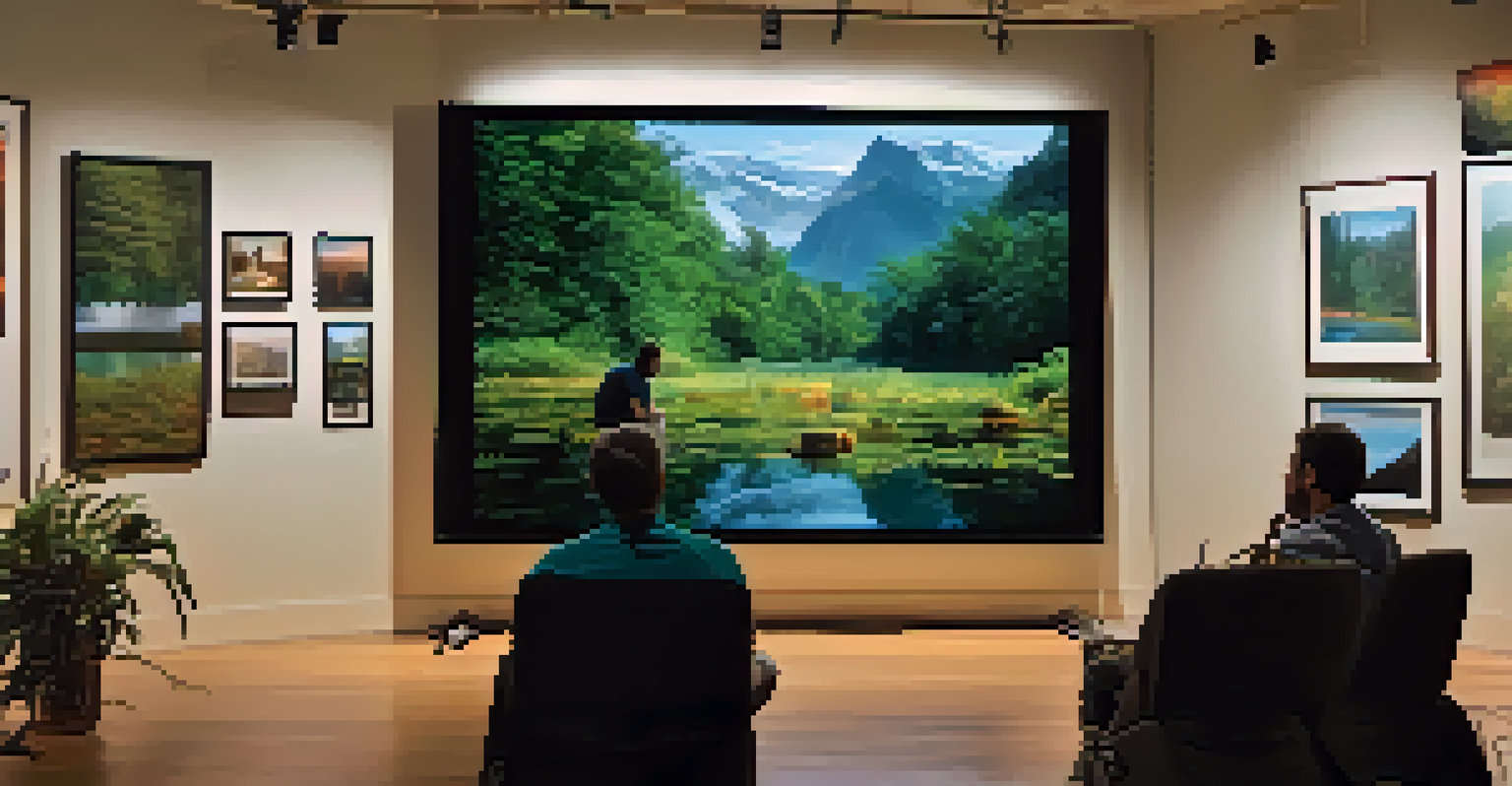The Role of Narration in Documentary Storytelling Techniques

Understanding the Essence of Documentary Narration
Documentary narration serves as the backbone of storytelling, guiding viewers through the narrative. It provides context and depth, helping audiences connect emotionally with the subject matter. Without effective narration, even the most visually stunning documentaries can fall flat, lacking the necessary engagement.
Documentary narration serves as the backbone of storytelling, guiding viewers through the narrative.
Narration often acts as a bridge between the viewer and the documentary's core message. By articulating thoughts, feelings, and insights, narrators help to interpret complex ideas in a digestible manner. This aspect is crucial, especially when tackling intricate subjects that may confuse or overwhelm the audience.
Additionally, the tone and style of narration can significantly influence the viewer's perception of the documentary. A warm, inviting voice can create a sense of intimacy, while a more authoritative tone may lend credibility. Striking the right balance is essential for crafting a compelling narrative.
Types of Narration in Documentaries
Narration in documentaries can be categorized into various styles, each serving a unique purpose. First-person narration offers a personal touch, immersing viewers in the narrator's experiences and emotions. This style can foster a strong connection, making the story feel relatable and engaging.

On the other hand, third-person narration provides a more objective perspective, allowing the audience to observe events without bias. This approach is often used in investigative documentaries, where neutrality is paramount. By presenting facts and insights from a distance, it enhances credibility and fosters trust.
Narration Enhances Emotional Connection
Effective narration draws viewers into the story, fostering empathy and understanding through personal insights.
Lastly, a mix of both first and third-person narration can be employed to create a dynamic storytelling experience. This technique allows filmmakers to share personal anecdotes while also providing a broader context, making the documentary multifaceted and rich in perspective.
The Emotional Impact of Effective Narration
One of the most powerful aspects of effective narration is its ability to evoke emotions. A well-crafted narrative can draw viewers into the story, making them feel the highs and lows alongside the subjects. For instance, a narrator's poignant reflections can amplify the emotional weight of a particular scene, leaving a lasting impression.
A well-crafted narrative can draw viewers into the story, making them feel the highs and lows alongside the subjects.
Moreover, narration can help to humanize the subjects of a documentary. When narrators share personal stories or insights, it allows viewers to see the individuals behind the statistics or headlines. This human connection can be transformative, fostering empathy and understanding.
In this way, narration does more than just tell a story; it invites the audience to experience it. By weaving emotional threads throughout the narrative, filmmakers can create a tapestry that resonates deeply with viewers, long after the credits roll.
Using Narration to Establish Tone and Mood
The tone and mood of a documentary are often established through the narration. For example, a somber, reflective narration can set a serious tone, guiding viewers to approach the subject matter with sensitivity. This is particularly important in documentaries that tackle difficult or controversial topics.
Conversely, a light-hearted or whimsical narration can create a more upbeat mood, encouraging viewers to engage with the content in a positive light. This technique can be especially effective in nature documentaries, where humor and joy can enhance the viewing experience.
Types of Narration Shape Storytelling
Different narration styles, such as first-person and third-person, serve unique purposes and influence how audiences perceive the documentary.
Ultimately, the choice of narration style and tone can significantly influence how viewers interpret and respond to the documentary. By carefully curating these elements, filmmakers can effectively shape the audience's emotional journey.
Complementing Visuals with Narration
In documentary filmmaking, visuals and narration work hand in hand to tell a cohesive story. While stunning visuals can capture attention, narration provides the necessary context to understand what the viewer is seeing. This synergy is vital for creating a comprehensive narrative that resonates.
For instance, when a documentary features breathtaking landscapes, narration can articulate the significance of these visuals, enriching the viewer's experience. By explaining the importance of a particular location or event, the narration enhances the visual storytelling.
Furthermore, effective narration can guide viewers' focus, directing attention to specific details that might otherwise go unnoticed. This intentionality helps to create a more immersive experience, allowing the audience to engage more deeply with the content.
The Role of Narration in Building Narrative Structure
Narration plays a crucial role in establishing the structure of a documentary. It can outline the storyline, introduce key themes, and highlight pivotal moments, creating a clear path for the viewer to follow. This organization is essential for maintaining engagement throughout the film.
Additionally, narration can serve as a tool for foreshadowing, hinting at future developments in the story. This technique builds anticipation and encourages viewers to stay invested in the narrative. For example, a narrator might pose a question early on that is answered later in the documentary, creating a sense of continuity.
Visuals and Narration Work Together
The synergy between visuals and narration is crucial for creating a cohesive narrative that enriches the viewer's experience.
By providing a framework for the narrative, narration helps to guide viewers through complex topics and emotions, ensuring that the story remains accessible and engaging from beginning to end.
Challenges in Crafting Effective Documentary Narration
While narration is a powerful tool in documentary storytelling, crafting it effectively presents several challenges. One of the main difficulties is striking the right balance between informative and engaging content. Narrators must convey essential information without overwhelming the audience or losing their interest.
Another challenge is maintaining authenticity while still being engaging. Viewers are often quick to dismiss narration that feels overly scripted or insincere. Finding a genuine tone that resonates with the audience is essential for fostering a connection and keeping them engaged.

Lastly, the risk of bias is always present in narration. Filmmakers must be aware of how their narration might influence viewer perceptions and strive for objectivity, especially in documentaries that address sensitive topics. This careful approach ensures that the documentary remains credible and respectful.
The Future of Narration in Documentary Filmmaking
As technology and storytelling techniques evolve, the role of narration in documentaries will continue to transform. Innovations in multimedia storytelling, such as interactive documentaries, challenge traditional narrative forms and invite exploration. In these formats, narration may evolve to become more dynamic and responsive to viewer choices.
Moreover, the rise of podcasts and audio storytelling has introduced new possibilities for narration in documentaries. Filmmakers can draw inspiration from these formats, experimenting with voice and sound to create immersive narratives that captivate audiences in new ways.
Ultimately, the future of narration lies in its ability to adapt and resonate with changing audience expectations. By embracing innovation while honoring the core principles of storytelling, documentary filmmakers can continue to craft compelling narratives that leave a lasting impact.